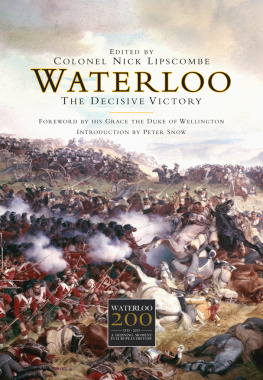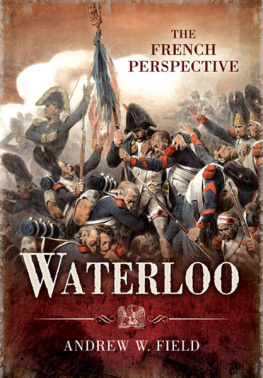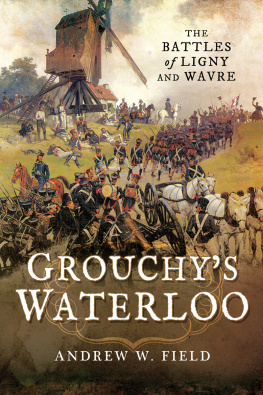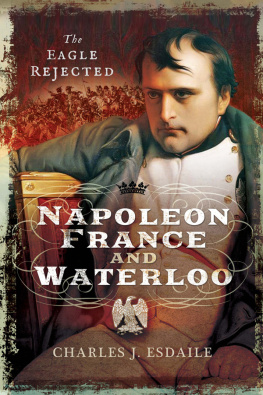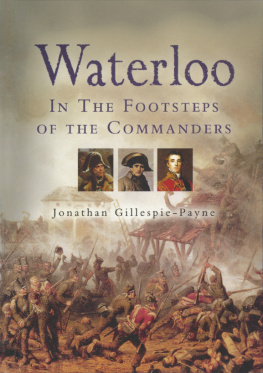French infantry in action guerrillas during the Peninsular War.

First published in Great Britain in 2007 by
Pen & Sword Military
an imprint of
Pen & Sword Books Ltd
47 Church Street
Barnsley
South Yorkshire
S70 2AS
Copyright Andrew Uffindell 2007.
ISBN 978-1-84415-249-0
Digital Edition ISBN: 978-1-84468-343-7
The right of Andrew Uffindell to be identified as Author of this Work has been asserted by him in accordance with the Copyright, Designs and Patents Act 1988.
A CIP catalogue record for this book is available from the British Library.
All rights reserved. No part of this book may be reproduced or transmitted in any form or by any means, electronic or mechanical including photocopying, recording or by any information storage and retrieval system, without permission from the Publisher in writing.
Typeset in 10/12 Ehrhardt by Concept, Huddersfield, West Yorkshire Printed and bound in England by Biddles Ltd
Pen & Sword Books Ltd incorporates the imprints of Pen & Sword Aviation, Pen & Sword Maritime, Pen & Sword Military, Wharncliffe Local History, Pen & Sword Select, Pen & Sword Military Classics and Leo Cooper.
For a complete list of Pen & Sword titles please contact
Pen & Sword Books Limited
47 Church Street, Barnsley, South Yorkshire, S70 2AS, England
E-mail:
Website: www.pen-and-sword.co.uk
Maps, Illustrations and Key to Maps
Maps
Plates
Between pages
Napoleon: detail from his statue at Montereau.
Wellington at Waterloo, after Sir Thomas Lawrence.
Blcher, sketched during his visit to England in June 1814.
Napoleon on the bridge at Arcole, 15 November 1796.
The Battle of Rivoli, 14 January 1797.
Austerlitz, 2 December 1805.
Napoleon and his staff.
Napoleon at Wagram, 6 July 1809.
The rout of Napoleons army after Waterloo, 18 June 1815.
Napoleon on HMS Bellerophon in July 1815.
Colonel the Hon. Arthur Wellesley in India, September 1800.
Wellington at Waterloo.
Major-General the Hon. Sir Arthur Wellesley in 1804.
Field Marshal the Duke of Wellington.
Blcher.
Gneisenau.
The Battle of Leipzig, 19 October 1813.
Illustrations
Frontispiece: French infantry in action against guerrillas during the Peninsular War
Key to Maps
 | Infantry |
 | Cavalry |
 | Artillery |
 | Division |
 | Corps |
 | Army |
Acknowledgements
I wish to thank all my family and friends for their support with this project, especially Rupert Harding of Pen and Sword Books for his advice and guidance; John Richards, who drew the excellent maps; Martin Rodgers; and the ever-helpful staff of the British Library, the Bibliothque Nationale de France and the German Historical Institute.
Introduction
Waterloo is one of the most important battles in history. It opened a new era, for it ended Napoleons extraordinary career and the two decades of conflict that had blighted Europe since the outbreak of war with Revolutionary France in 1792.
But the decisiveness of Waterloo has distorted the popular view of the three army commanders who fought there. Of all Napoleons battles, it is his defeat at Waterloo that is the most famous, rather than such victories as Marengo, Austerlitz, Jena or Friedland. Similarly, the commanders who beat him were remarkable men in their own right and had made a name for themselves even before the battle. The Duke of Wellington helped to establish British imperial power in India and then made his reputation defeating a series of French marshals in the Peninsular War (180814). Indeed, some of his Indian and Peninsular achievements required more skill and imagination than his straightforward, attritional defence at Waterloo, as he himself pointed out: It is generally thought that the Battle of Waterloo was one of the greatest battles ever fought; such is not my opinion, but I say nothing upon that point.
Wellingtons ally, the Prussian commander-in-chief, Prince Gebhard Leberecht von Bliicher, was a seventy-two-year-old who had first seen service in the Seven Years War (1756-63) and since acquired a wealth of experience fighting the French during the Revolutionary Wars and in the campaign of 1806, before winning fame at the head of the Army of Silesia in the campaigns of 1813-14, which ended with Napoleons first abdication. Yet his career has also been overshadowed, at least outside Germany, by his final battle at Waterloo.
It would be difficult to find a more extraordinary combination of commanders than these three men, or more intriguing contrasts in personalities and styles of leadership. This book has been written to explore these contrasts and the lessons to be learned from them. It concentrates on their military careers and offers an analysis of their strengths and weaknesses as soldiers. Their political and private lives have been covered as far as is necessary to understand them as military commanders, and more information on these aspects can be found in the suggestions for further reading at the end of this book. Similarly, the composition, tactics and weapons of their armies will be covered in detail in a companion title, Waterloo Armies, by Philip Haythornthwaite.
These books are intended to supplement Pen and Swords Battleground Europe volume, Waterloo: The Battlefield Guide, and to provide both the battlefield visitor and the armchair reader with a fuller understanding of how and why Waterloo was fought and won.
Chapter 1
Formative Years
Despite his status as a great French national hero, Napoleon was actually the son of Corsican freedom fighters who opposed the French annexation of the island. For the first twenty-three years of his life, he identified with Corsica as his homeland and saw France as an oppressor, even after spending over seven years at schools in France and being commissioned a French officer. He owed much of his character to his childhood on Corsica, including his proudly independent spirit, superstition and a strong sense of clan loyalty.
Youth and Education
Napoleon was born on 15 August 1769 at Ajaccio, the Corsican capital. Although originally from Tuscany, his family, the Buonapartes, had lived on the island for three centuries. His father, Carlo-Maria Buonaparte, had married Maria-Letizia Ramolino, the daughter of an inspector of roads and bridges, in 1764, when he was eighteen and she just fourteen. When King Louis XVI of France annexed Corsica in May 1768, Carlo joined the patriot Pasquale Paoli in resisting the occupation and was seen as a possible successor to him. Letizia was actually pregnant with Napoleon when she and Carlo fled through the mountains following Paolis decisive defeat at Ponte Nuovo on 9 May 1769. Paoli went into exile in June, his men were allowed to return home, and Letizia reached Ajaccio in time to give birth. Napoleon was given his unusual name because Carlo followed the example of his grandfather, who had called his sons Joseph, Napoleon and Lucien.







